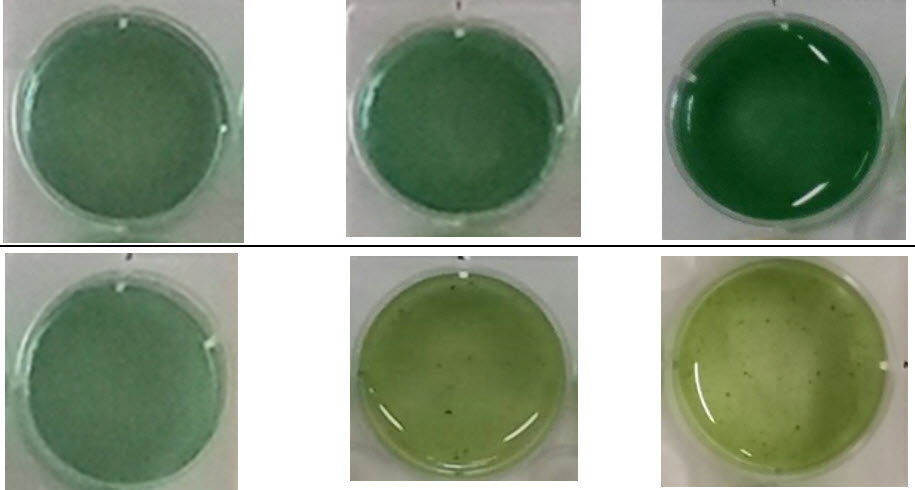การเจริญและการแสดงออกของยีนที่สัมพันธ์กับพีเอชเอของสไปรูไลนา พลาเทนซิสที่เลี้ยงในอาหารเลี้ยงที่ขาดไนเทรตและอาหารเลี้ยงที่เสริมแอซิเทต
Main Article Content
Abstract
Chanchanok Duangsri and Wuttinun Raksajit
รับบทความ: 9 พฤษภาคม 2560; ยอมรับตีพิมพ์: 22 กันยายน 2560
บทคัดย่อ
พอลิไฮดรอกซีอัลคาโนเอต (พีเอชเอ) เป็นพอลิเอสเทอร์แบบเส้นตรงซึ่งสามารถผลิตและสะสมได้โดยสไปรูไลนา พลาเทนซิส พีเอชเอเป็นพอลิเมอร์ที่สามารถย่อยสลายได้ทางชีวภาพ ถูกสังเคราะห์ขึ้นจากเอนไซม์ PHA synthase ซึ่งเป็นเอนไซม์ที่ถูกแปลรหัสจากยีน phaC พีเอชเอที่ผลิตขึ้นจากสไปรูไลนา พลาเทนซิส เป็นพอลิเมอร์ที่สามารถเข้ากันได้กับเซลล์และเนื้อเยื่อสัตว์ ในการศึกษาครั้งนี้มีวัตถุประสงค์เพื่อศึกษาผลของการขาดไนเทรตและการเติมแอซิเทตต่อการเจริญและการแสดงออกของยีน phaC ของสไปรูไลนา พลาเทนซิส ผลการวิจัยพบว่า การเลี้ยงเซลล์ในอาหารเลี้ยงที่ขาดไนเทรตส่งผลให้การเจริญของสไปรูไลนา พลาเทนซิสลดลง มีการเปลี่ยน แปลงสีของเซลล์จากสีเขียวเป็นสีเหลืองในช่วงระยะเวลา 3 วัน การเติมแอซิเทต 0.25 – 0.50%(w/v) ลงในอาหารเลี้ยงที่ขาดไนเทรตมีส่วนช่วยบรรเทาผลกระทบต่อการเจริญเติบโตของสไปรูไลนา พลาเทนซิส จากผลของ RT-PCR แสดงให้เห็นว่าอาหารเลี้ยงที่ขาดไนเทรตและมีการเติมแอซิเทต 0.50%(w/v) เหนี่ยวนำการแสดงออกของยีน phaC สูงที่สุด (p < 0.05) ที่เวลา 6 ชั่วโมงของการปรับตัว
คำสำคัญ: พอลิไฮดรอกซีอัลคาโนเอต สไปรูไลน่า พลาเทนซิส ยีน phaC ไนเทรต แอซิเทต
Abstract
Polyhydroxyalkanoates (PHAs) are linear polyhydroxyesters that can be produced and accumulated by Spirulina platensis. The PHAs are biodegradable polymer generated by PHA synthase which is encoded by phaC. PHAs generated from S. platensis are biocompatible polymers with animal cells and tissues. In the present study, the influences of nitrate deprivation and acetate supplementation on growth and expression of the phaC gene of S. platensis were investigated. In the absence of nitrate, S. platensis growth was reduced. The cells changed from green to yellow within 3 days. The addition of 0.25–0.50% (w/v) acetate to cultures could alleviate the effects of nitrate deprivation on growth of S. platensis. RT-PCR clearly showed that nitrate-deprived culture containing 0.50% (w/v) acetate induces the expression of this phaC gene (p < 0.05) at 6-hour adaptation.
Keywords: Polyhydroxyalkanoates, Spirulina platensis, phaC gene, Nitrate, Acetate
Downloads
Article Details

This work is licensed under a Creative Commons Attribution-NonCommercial 4.0 International License.
References
Drosg, B., Fritz, I., Gattermayr, F., and Silvestrini, L. (2015). Photoautotrophic production of poly(hydroxyalkanoates) in cyanobacteria. Chemical and Biochemical Engineering Quarterly 29(2): 145–156.
Duangsri, C., and Raksajit, W. (2016). Polyhydroxyalkanoates: An alternative biomaterial for renewable plastic. Journal of Research Unit on Science, Technology and Environment for Learning 7(2): 414–423.
Emadian, S. M., Onay, T. T., and Demirel, B. (2017). Biodegradation of bioplastics in natural environments. Waste Management 59: 526–536.
Ihlenfeldt, M. J., and Gibson J. (1977). Acetate uptake by the unicellular cyanobacteria Synechococcus and Aphanocapsa. Archive Microbiology 113(3): 231–241.
Jau, M.-H., Yew, S.-P., Toh, P.S.Y., Chong, A.S.C., Chu, W.-L., Phang, S.-M., Najimudin, N., and Sudesh, K. (2005). Bio-synthesis and mobilization of poly(3-hydroxybutyrate) [P(3HB)] by Spirulina platensis. International Journal of Biological Macromolecules 36(3): 144–151.
Keshavarz, T., and Roy, I. (2010). Polyhydroxyalkanoates: bioplastics with a green agenda. Current Opinion in Microbiology 13(3): 321–326.
Khetkorn, W., Incharoensakdi, A., Lindblad, P., and Jantaro, S. (2016). Enhancement of poly-3-hydroxybutyrate production in Synechocystis sp. PCC 6803 by overexpression of its native biosynthetic genes. Bioresource Technology 214: 761–768.
Lane, C. E., and Benton, M. G. (2015). Detection of the enzymatically-active polyhydroxyalkanoate synthase subunit gene, phaC, in cyanobacteria via colony PCR. Molecular and Cellular Probes 29(6): 454–460.
López, N. I., Pettinari, M. J., Nikel, P. I., and Méndez, B. S. (2015). Polyhydroxyalkanoates: Much More than Biodegradable Plastics. Advances in Applied Micro-biology 93: 73–106.
Meeks, J. C., and Castenholz, R. W. (1971). Growth and photosynthesis in an extreme thermophile, Synechococcus lividus (Cy-anophyta). Archivfür Mikrobiologie 78(1): 25–41.
Mendhulkar, V. D., and Shetye, L. A. (2017) Synthesis of biodegradable polymer poly hydroxyalkanoate (PHA) in cyanobacteria Synechococcus elongates under mixotrophic nitrogen- and phosphate-mediated stress conditions. Industrial Biotechnology 13(2): 85–93.
Ng, L.-M., and Sudesh, K. (2016). Identification of a new polyhydroxyalkanoate (PHA) producer Aquitalea sp. USM4 (JCM 19919) and characterization of its PHA synthase. Journal of Bioscience and Bioengineering 122(5): 550–557.
Nishioka, M., Nakai, K., Miyake, M., Asada, Y., and Taya, M. (2001). Production of poly-β-hydroxybutyrate by thermophilic cyanobacterium, Synechococcus sp. MA19, under phosphate-limited conditions. Biotechnology Letters 23(14): 1095–1099.
Rehm, B. H. A. (2007). Biogenesis of microbial polyhydroxyalkanoate granules: A platform technology for the production of tailor-made bioparticles. Current Issues in Molecular Biology 9(1): 41–62.
Sharma, G., Kumar, M., Ali, M. I., and Jasuja, N. D. (2014). Effect of carbon content, salinity and pH on Spirulina platensis for phycocyanin, allophycocyanin and phycoerythrin accumulation. Journal of Microbial and Biochemical Technology 6(4): 202–206.
Sharma, L. and Mallick, N. (2005). Accumulation of poly-b-hydroxybutyrate in Nostoc muscorum: regulation by pH, light-dark cycles, N and P status and carbon sources. Bioresource Technology 96: 1304–1310.
Summers, M. L., Denton, M. C., and McDermott, T. R. (1999). Genes coding for phosphotransacetylase and acetate kinase in Sinorhizobium meliloti are in an operon that is inducible by phosphate stress and controlled by phoB. Journal of Bacteriology 181(7): 2217–2224.
Wang, Y., Yin, J., and Chen, G.-Q. (2014). Polyhydroxyalkanoates, challenges and opportunities. Current Opinion in Biotechnology 30: 59–65.
Zarrouk, C. (1966). Contribution al’etuded’une cyanophycee. Influence de Divers Facteurs Physiques Et chimiquessur la croissanceet Photosynthese de Spirulina maxima, (Setch et Gardner) Geitler. Ph.D. Thesis. Paris: University of Paris.
